Mud kitchens are a fantastic way to promote creative play and get kids outdoors. By providing them with their own miniature kitchen, children can use their imaginations to create recipes, inventions and make-believe meals. They can also learn about food safety, hygiene, measurements and weights. Mud kitchens provide hours of fun for the little chefs in your life.
What Is A Mud Kitchen?

A mud kitchen is exactly what it sounds like – a miniature kitchen made out of mud and other natural materials. It can be as simple or complex as you’d like, but typically includes an area to prepare food, such as a benchtop, sink with running water and shelves. You can also include extras like utensils, pots and pans, and even a stove or oven.[1]
Add A Working Tap To Your Mud Kitchen
Adding a tap to your mud kitchen is a great way to make the experience even more fun and realistic. A working tap can provide a source of running water for kids to use in their mud kitchen creations without having to worry about spilling or wasting water from other sources. You can buy taps that attach directly to garden hoses or, for a more realistic experience, you can use a recirculating pump to create the sensation of running water.
To install a tap to your mud kitchen, first make sure that the area where it is going is suitably waterproof and secure so that any water spills will not cause damage. Then connect the tap to the hose or pump you have chosen.[1]
Decorate Your Mud Kitchen With Complementary Details
Now you have the basic components for your mud kitchen, but don’t forget about the details that make it special! Start with a few items to make your mud kitchen unique. If the children are going to be playing in it, then add items that they can use to interact with their environment. For example:
- Plastic or rubber animals
- Plastic utensils, dishes and cups
- Toy vehicles like cars or trucks
- Dolls and stuffed animals
- A pretend stove for cooking up mud pies
- An outdoor rug to make the area cozy
- Sand pails, sieves, funnels, and small shovels[1]
Take Your Mud Kitchen Up A Notch With Stepping Stones
If you want to take your mud kitchen to the next level, think about adding some stepping stones. Not only do they add another layer of texture and design to your outdoor play area, but they also serve as a great way to help teach children balance, coordination and planning skills.
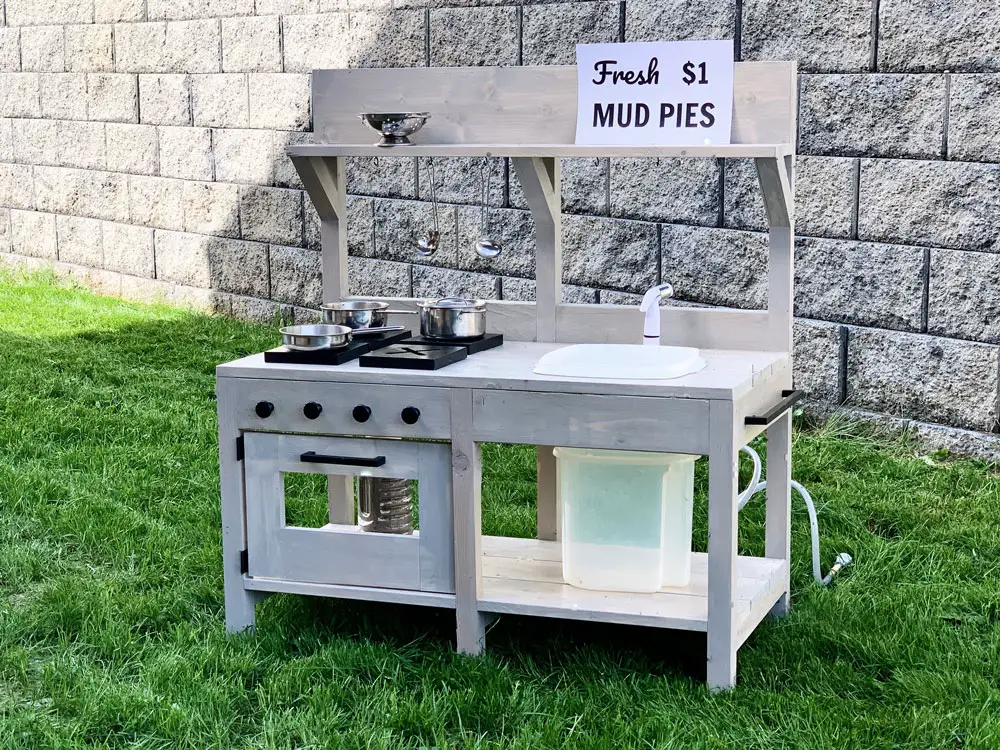
You can easily make your own stepping stones with items you probably have around your home. All you need is a few stones, some cement, and maybe a bit of paint.
Once the stepping stones are dry, place them in strategic locations around the mud kitchen area to create pathways or garden beds. This provides an additional physical challenge for children to navigate through as they explore their mud kitchen.
Get Creative With Dry Materials
Using dry materials, like soil, sand and pebbles or water-absorbent dried leaves is a great way to create a mud kitchen. Dry materials are easy to find around the house and in nature so it can be an affordable option as well. They’re also much easier to clean up than wet mud.
Create a garden patch in your mud kitchen by using soil, stones and pebbles. You can also add dried leaves to create texture and let the kids explore how the different elements interact with each other. Children will have lots of fun mixing things like water, sand or soil together to make mud pies, cakes or sculptures.[1]
Grab The Paints And Decorate Stones
You can also use rocks and stones to make your mud kitchen area even more interesting. Get some non-toxic paints, brushes and other art supplies and let the kids have fun creating their own designs on the rocks. You could even challenge them to try and create a series of pictures that tell a story or create something with a specific theme.
Once the kids have finished their art, you can use them to decorate your mud kitchen area and add an extra bit of fun. Just be sure to keep all paint brushes and supplies out of reach when not in use! Then, your kids will have hours of fun creating stories with the rocks they’ve decorated.[1]
Grow Sensory Herbs For Texture And Fragrance
Adding herbs to your mud kitchen can provide a whole new level of sensory experience. Different herbs will offer different textures and aromas, making them perfect for exploring in the garden.
Mint, oregano, thyme, basil and chamomile are all great options! For younger children, you could also add edible flowers like cornflowers or pansies.
You could even create a dedicated herb garden for them, to encourage your little ones to get involved in gardening and grow their own food. Plant the herbs in pots so that they can be moved around the kitchen, this way your kids can explore different textures and smells from one day to the next. Nothing beats making mud pies with freshly picked herbs!
You could also involve your little ones in the harvesting process – let them pick their own herbs and flowers to add to their masterpieces. You’ll be able to teach them about plants, gardening and food production at the same time as providing a fun learning experience. [1]
Upcycle Tins To Make Cute Containers
Upcycling is a great way to make use of old materials and create something new – perfect for making your own mud kitchen! Tins are an ideal material for this. Start by cleaning the tin, removing labels and ensuring there’s no sharp edges. Once you’ve done that you can get creative and decorate the tin with paint or fabric. Once you’ve finished decorating, you can add handles to the tins so they become portable. You could also use a drill and some eyelets to attach some rope – perfect for hanging items in your mud kitchen!
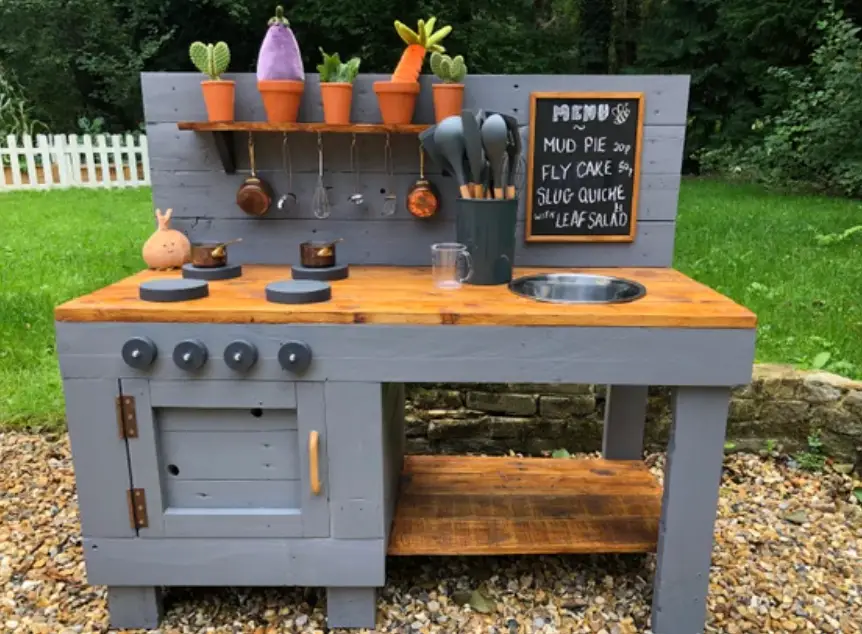
These tins can then be used as containers for ingredients like water, sand and soil, and you can even decorate them further with stickers or ribbons. You can also make use of any old bowls or utensils you have lying around to create your mud kitchen. Just be sure to supervise your kids while they are playing, as some of these items may not be suitable for children due to small parts or sharp edges.[1]
Make A Water Wall
Another great way to spruce up your mud kitchen is to make a water wall. You can create a simple wooden frame and stretch a sheet of plastic or vinyl over it, making sure all the corners are securely fastened with duct tape. Then, attach several spray nozzles at different heights so you can adjust the flow of water as you need. This is an easy and interactive addition to your mud kitchen, and kids of all ages will love it! You can make the water wall as simple or as complicated as you want – adding suction cups onto the plastic sheeting to attach buckets, tubes, funnels and other items of different shapes and sizes.[2]
Make Mud Muffins
Mud muffins are a classic mud kitchen activity! To make your own, simply mix together some soil and sand. You can also add in some water to give the mixture a gooey texture that’s fun to knead and shape into different forms. Topping it off with natural elements like twigs, leaves, and rocks gives the “muffins” a realistic look. Kids can play pretend by baking these in their mud kitchen, or you can even give it a try in an outdoor oven![2]
Provide Plenty Of Collecting Tins
Kids love collecting things, and what better way to encourage that than with a collection of tins.
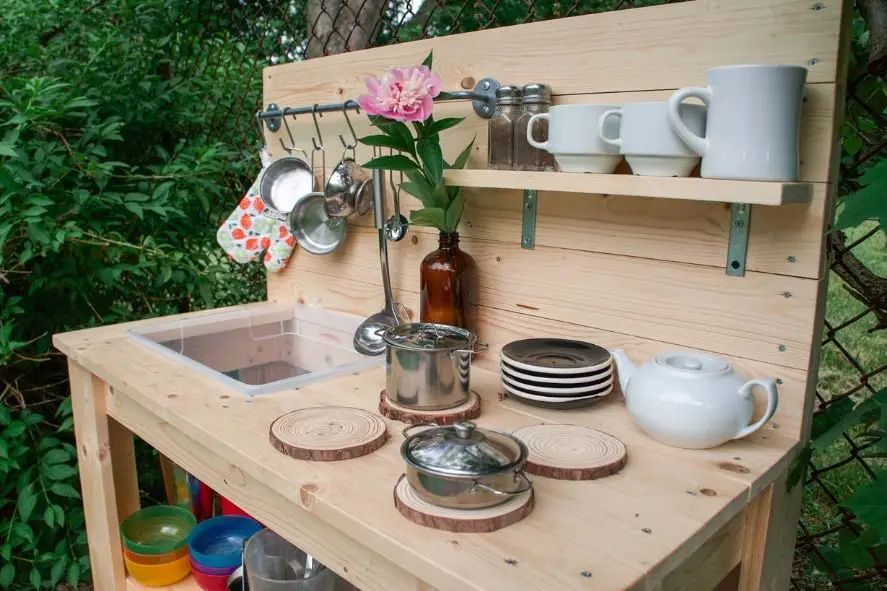
Choose different shapes, sizes and colors for the bins and fill them up with mud kitchen ingredients such as stones, leaves, bark chips etc – anything that can be collected to use in their mud creation. Some parents also like to add items like utensils and old toys, which can be safely washed in the mud kitchen after playtime.
You can store these tins outside in a shed or garage or even inside the house if you’d prefer. This way, when your little one is done playing with their mud kitchen creations they have an easy place to put everything away.
Another great idea is to start a scavenger hunt list for the kids. This can include items that they can collect from around the garden and add to their tins, such as pine cones and pebbles. This will encourage exploration and imagination while keeping them entertained at the same time.[2]
Concoct Some Magical Potions
Let your children create some interesting, magical concoctions with mud. Mud kitchen ideas can include making potions with dirt and water, stirring them up in a pot and adding some natural ingredients like stones or pinecones for extra flair. This activity is great for developing creative thinking skills as well as fostering an interest in science.
You can also provide other tools, such as measuring cups and spoons, so they can pretend to measure out some of the ingredients. You could even add a few drops of food coloring for color variation. This activity is perfect for your budding scientists![2]
Customize Your Own Mud Kitchen
If you’re looking for ways to get creative and make your own mud kitchen, there are plenty of options available. You can either buy a pre-made kit or build one yourself with the materials you have on hand.
One great way to customize your mud kitchen is to choose the right size and shape for it. If you have a large enough backyard, you can make a full-sized mud kitchen complete with appliances and running water. Or, if space is limited in your yard, go for something smaller that will fit nicely and provide plenty of fun activities.
Another way to customize your mud kitchen is to choose materials. You can use traditional building materials like wood or metal, or you can go for something more unique like recycled materials. With a bit of creativity and imagination, you can create a beautiful and functional kitchen from almost anything.[2]
Add Bubbles To The Mix
Adding bubbles to the mix is a great way to add some extra fun and excitement to your mud kitchen. You can use store-bought bubble machines or you can make your own bubble solutions by mixing dish soap, water, and food coloring. Make sure that you supervise your little ones while they are playing with the bubbles, especially if they are younger than three years old. You can also purchase some bubble blowers that you can use to blow bubbles over your mud kitchen creations! This will definitely help make the experience an even more special one for your child.[2]
Splash Out On The Right Clothing
One of the most important parts of having a successful Mud Kitchen experience is to make sure you are dressed for the part. It’s not just about staying clean and dry, but also about looking the part. Invest in some waterproof clothing such as raincoats and wellies so that your little one can get stuck into their mud kitchen with ease. This will also ensure that they are protected from any of the elements and can enjoy their time outdoors to the fullest.
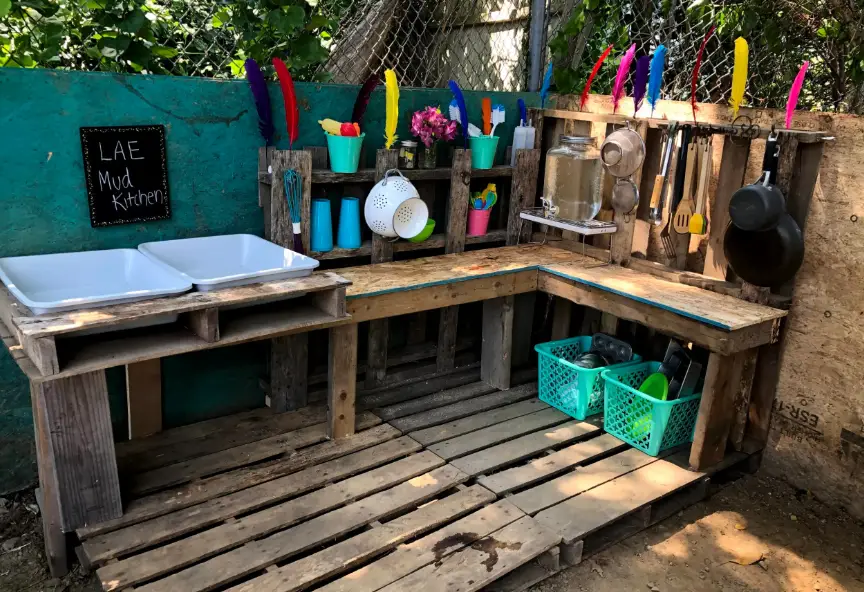
It’s also important to make sure your little one is wearing clothes that you don’t mind getting a bit mucky, as mud kitchens can get pretty messy at times! If you want to go the extra mile, why not let them choose some of their own special Mud Kitchen clothes so that they feel like a real chef in their outdoor kitchen.[1]
Get Growing For Spring
Spring is the perfect time to start developing your outdoor mud kitchen ideas. Fill up those flower beds with fresh soil, get some vegetable seeds planted, and watch your plants come to life! Gardening can be a great way for children of all ages to develop an appreciation for nature and provides them with plenty of opportunity to use their imagination.[1]
Play With Tactile Treasures
Kids love feeling different textures, so why not make their playtime a bit more interesting with tactile treasures? Add items such as sand, pebbles, shells, fabric scraps and other textured materials to the mud kitchen. You can also arrange them in buckets or trays for children to explore and mix together. This will add a sensory element to their play and help them develop their fine motor skills.
Letting kids explore tactile treasures in their mud kitchen is a great way to get them interested in the kitchen and learn more about dirt, sand and other materials. Plus it’s an excellent way to keep them busy while they learn invaluable life lessons![1]
Get Down To Eye Level
When it comes to creating a mud kitchen, getting down to your kid’s eye level can go a long way. Let them get involved and help you decide the best location for their kitchen and the kind of supplies they will use. Ask them if they have any special requirements; this could be anything from a ‘washing station’ with buckets and scourers or a ‘cooking station’ with plates, utensils and chopping boards.
Once you’ve got the location sorted, it’s time to get creative! Consider using items such as old kitchen sinks, plastic tubs and trays for your mud kitchen. Add some sticks, stones and shells to create a fun play area.
If you’re looking for something a little more permanent, consider building your own mud kitchen using wood or plastic panels and other materials such as corrugated iron, drystone walls and sand pits.[2]
Encourage Barefoot Exploring
Encouraging your kids to explore the mud kitchen with their bare feet is a great idea! Not only will they enjoy feeling the sensations of wet and squishy mud between their toes, but they’ll also be getting fresh air, exercise and plenty of outdoor fun. You can make it even more enjoyable by providing them with some waterproof sandals and even some waterproof overalls.[2]
Make Treats For The Birds
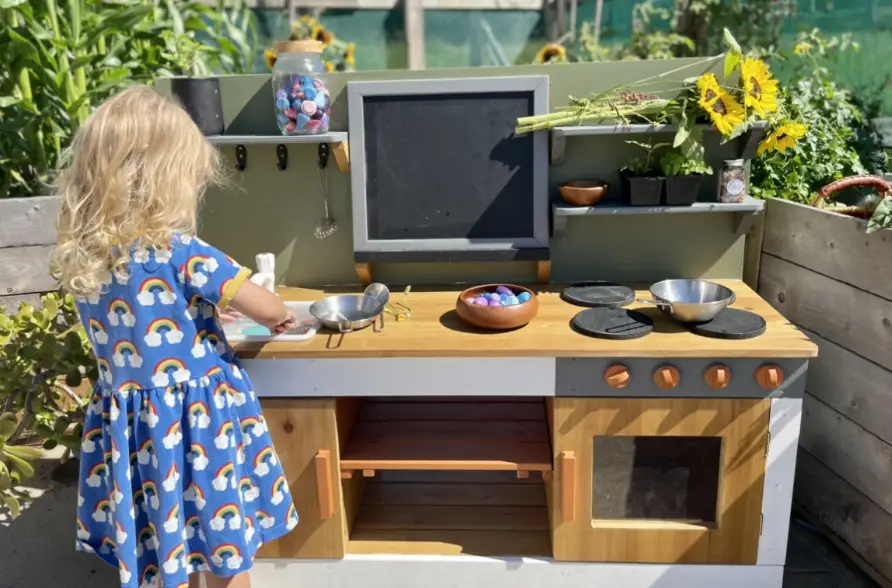
One of the most fun activities you can do with your mud kitchen is to make treats for the birds! This activity will encourage children to observe and learn about different types of birds, as well as their behaviors. To create bird-friendly snacks, mix together ingredients such as oats, seeds, dried fruit and nuts in a bowl or tray. Place this mixture near your mud kitchen and watch as the birds come to enjoy their nutritious feast! This activity is also great for teaching children about the importance of caring for nature.[2]
Add A Row Of Stepping Stones
Adding stepping stones to your mud kitchen is a great way to add texture and functionality. You can either buy small stepping stones from a garden center or make them yourself with logs, cardboard boxes, bricks, or large rocks. Line up the stones from one end of the kitchen to the other and fill in the gaps between them with soil or compost. Kids will love hopping from one stone to the other as they stir and mix their mud concoctions. You can also use the stones as planters for growing herbs or flowers, making your mud kitchen even more inviting.[2]
What Age Are Mud Kitchens For?
Mud kitchens are a great activity for children of all ages. Even babies can enjoy playing with mud and exploring the texture, temperature, and smells associated with it. Mud kitchen activities can be tailored to each age group in order to create an engaging and educational experience.
For toddlers and preschoolers, you can set up a sensory table for them to explore and create with.
You can also provide simple utensils such as spoons, cups, funnels, etc. so they can experiment with transferring material from one container to another.
For older children like school-age kids, you can provide more complex items such as mortar and pestles, rolling pins, and measuring cups to help them create more elaborate recipes. Additionally, you can set up activities such as a scavenger hunt using natural items found in your garden or outdoors for extra creativity and fun.[2]
Why Are Mud Kitchens Beneficial?
Mud Kitchens are becoming increasingly popular among parents and educators as they provide a range of developmental benefits for children. From problem-solving to language development, the experiences that come with engaging in mud kitchen activities can be incredibly valuable.
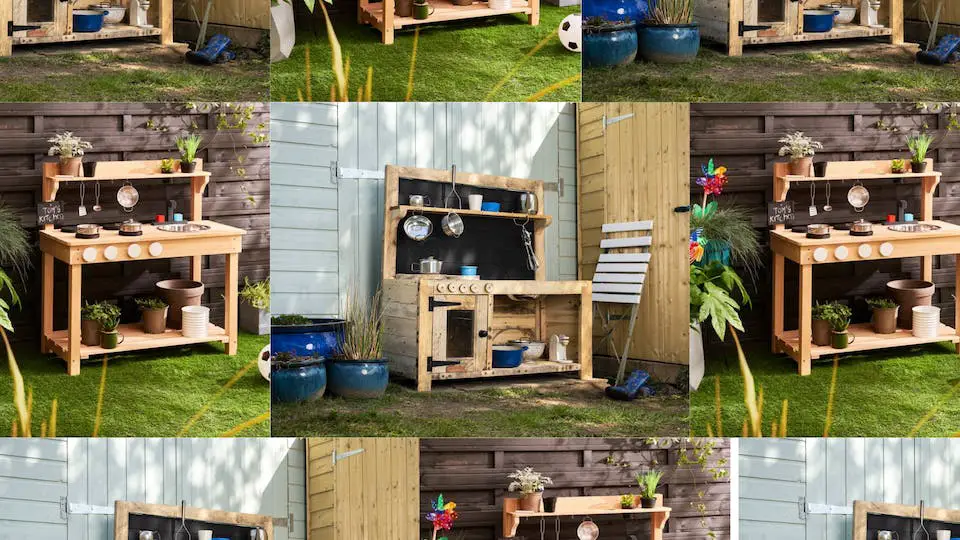
Creating a mud kitchen is also a great opportunity for children to experience sensory play, allowing them to explore the different textures, smells and sounds that mud can offer. Mucking about in a mud kitchen will also encourage children to think creatively as they come up with unique recipes or build structures from their mud creations.
Children are naturally drawn to the natural environment, so a mud kitchen gives them an opportunity to learn more about nature while having fun. Mud kitchens also provide a great outlet for children to be creative and use their imaginations, helping them develop their motor skills and hand-eye coordination as they play.[2]
FAQ
Is a mud kitchen a good idea?
A mud kitchen can spark a child’s imagination and provide hours of fun. Because mud contains many different materials, it can be a great medium for tactile exploration and sensory play. Kids also use their imaginations to create recipes, make pretend dishes, or act out stories while playing in the mud kitchen outdoors.
What is the point of a mud kitchen?
The point of a mud kitchen is to give kids a creative and safe way to explore their environment, use their imaginations, and develop important motor skills. It encourages children to experiment with different materials like mud, sand, rocks, leaves, twigs, flowers, shells and more. This type of play encourages open-ended exploration and creativity.
How do you make a simple mud kitchen?
Making a simple mud kitchen is easy and can be done in just a few steps. First, you’ll need to find an area outdoors with some light shade that your child can play in safely. Then, fill containers or buckets with mud or soil, add water if necessary, and stir the mixture until it has a nice consistency. Finally, gather a variety of natural materials like rocks, twigs, leaves and shells to add to the kitchen. You can also include some simple tools like spoons, shovels and measuring cups for your child to use.
Is a mud kitchen Montessori?
Yes, a mud kitchen is an activity that fits perfectly into Montessori philosophy. Through free exploration and hands-on play, children can develop essential skills such as problem solving, creativity, fine motor skills, and self-regulation. A mud kitchen also encourages respect for nature and helps kids understand their place within the natural environment.
What are the rules for a mud kitchen?
The rules for a mud kitchen should be tailored to each individual child. Generally, though, it’s important to emphasize safety and respect for the environment. For example, if you’re using tools in the mud kitchen, make sure they are age-appropriate and that your child knows how to use them safely. It’s also important to explain which materials are safe to play with and where the boundaries are for exploring. Finally, remind your child that it’s OK to make a mess, but not to overdo it or damage any of the materials in the mud kitchen.
What are the risks of a mud kitchen?
The risks of a mud kitchen are minimal, but it’s still important to keep safety in mind. Make sure that any tools your child is using are age-appropriate and that they are supervised at all times. The mud mixture should be checked regularly for sharp objects or debris that could cause injury. As with any outdoor activity, be aware of other hazards such as ticks, poison ivy, and stinging insects.
What are the 5 basic rules for the kitchen?
- Be safe: Make sure all tools are age-appropriate and that your child knows how to use them safely. Supervise children at all times, especially when using the mud kitchen.
- Respect nature: Remind your kids to respect the environment and not damage any of the materials or natural elements in the mud kitchen.
- Have fun: Encourage your child to explore the mud kitchen and use their imagination to create recipes or act out stories while playing.
- Clean up: After playtime, make sure that all materials are put away in a safe place. If necessary, clean up any messes created during the activity.
- Be mindful: Remind your child that it’s OK to make a mess, but not to overdo it. Teach them the importance of using natural materials responsibly.
What is the best dirt for making mud?
The best dirt for making mud is a mixture of loam, clay and organic matter. Loam has a balanced ratio of sand, silt and clay particles which helps the mud retain moisture and makes it easier to shape. Clay provides structure and stability that prevents the mud from becoming too thin or watery.
Finally, adding some organic matter like leaves or compost can help boost the nutritional content of the mud. If you’re not sure what type of soil to use, it’s a good idea to consult with your local nursery or gardening center for advice.
Useful Video: Mud kitchen
Conclusion
Mud kitchens are a great way to get your kids out in the garden and having fun while learning. They can help children explore their creativity, develop skills like problem solving and hand-eye coordination, and use their imagination. Whether you opt for a simple DIY project or purchase a pre-made model, mud kitchen activities are sure to keep your child entertained for hours. With so many options available, you’re sure to find a perfect mud kitchen setup that will suit both your budget and the needs of your family.
We hope this article has helped answer some of the questions you have about Mud Kitchen Ideas and provided useful tips on how to create an amazing outdoor learning environment for your kids. If you have any questions not covered in this article, don’t hesitate to reach out and get in touch with us. We’re always happy to help. Thanks for reading!
Happy Mudding!
References
- https://www.bbcgoodfood.com/howto/guide/mud-kitchen-ideas
- https://www.gardeningetc.com/design/mud-kitchen-ideas





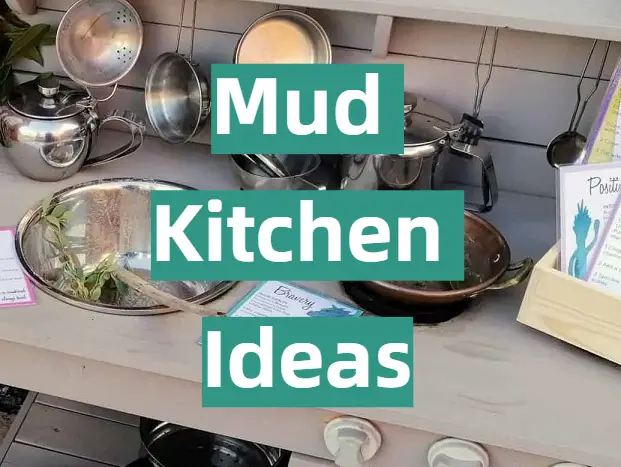




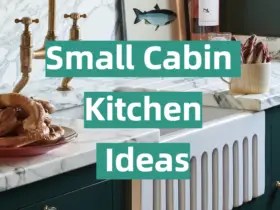
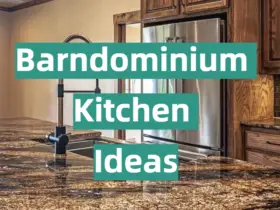

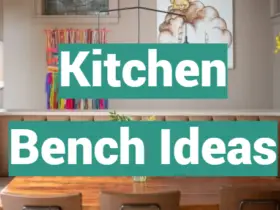
Leave a Reply